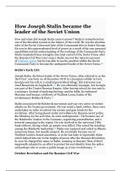How Joseph Stalin became the
leader of the Soviet Union
How and when did Joseph Stalin come to power? Stalin is remembered as
one of the bloodiest tyrants in the history of the world. He was the absolute
ruler of the Soviet Union and later of the Communist bloc in Easter Europe.
He rose to this unprecedented level of power as a result of his own personal
capabilities and his understanding of the workings of the Communist Party.
Stalin translated these strengths into total control of the Soviet Union after
the Russian Civil War (1917-1920). Stalin was not the natural successor
of Vladimir Lenin, but he was able to use his position within the Soviet
Communist Party to become the undisputed leader of the Soviet Union. [1]
Stalin’s Early Life
Joseph Stalin, the future leader of the Soviet Union, often referred to as the
‘Red Tsar', was born on 18 December 1878 to a Georgian cobbler in Gori,
Georgia and his wife in a small impoverished village. His real name was
Josef Besarionis de Jughashvili. [2] He was ethnically Georgian, but Georgia
was part of the Tsarist Russian Empire. After leaving school, he was sent to
a seminary. Instead of studying theology and the bible, he embraced
Marxism and became a follower of Vladimir Lenin, leader of the
revolutionary Bolshevik Party.[3]
Stalin soon joined the Bolshevik movement and was very active in violent
attacks on the Tsarist government. He was noted a bank robber, these were
undertaken in order to subvert the system and gain funds for the
revolution. After being placed under surveillance by Russian secret police,
the Ohrakan, for his activities, he went underground.[4] He became one of
the Bolsheviks' leaders in the Caucasus, organizing paramilitaries, and a
terrorist campaign in the region. He was involved in the notorious Tiflis
bank robbery, during which 40 people were killed. This raised his standing
among the Bolshevik leadership.[5] Stalin was captured and exiled to Siberia
numerous times, but usually escaped. He eventually became one of
Vladimir Lenin's closest associates, or so he was later to vigorously claim
which helped him rise to the heights of power after the Russian Revolution.
In 1910 he changed his name to Stalin, meaning in Russian ‘Man of Steel’
supposedly adopted in an effort to protect his real identity from the police
and perhaps also to create a public image as a true revolutionary. [6]
October Revolution and the Russian Civil War





